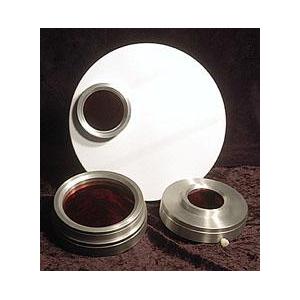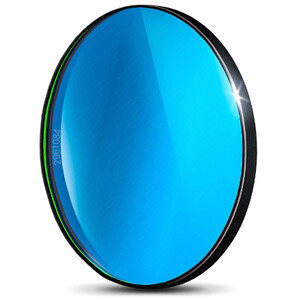Baader Sundancer II for observing and photographing the Sun
The Baader Sundancer II with heated H-alpha Etalon with 23mm aperture from SolarSpectrum - quickly and easily converts smaller refractors into telescopes for observing the Sun in the H-alpha line: observe the Sun's chromosphere with dark filaments, bright flares and spectacular prominences on the Sun's surface!
The Sundancer is simply inserted between the diagonal mirror and the eyepiece or camera, and connects to a power source. It then automatically heats up to the optimum operating temperature - no adjustment is necessary even during long periods of observation. The power supply can be easily provided using the power supply included, or an optional power tank.
Fine-tuning the transmission line to suit different telescope systems is possible using the control box. The micrometer screw allows the transmission to be quickly shifted into the blue wing of the H-alpha line to compensate for the Doppler effect during fast H-alpha events on the surface of the Sun.
The Sun in H-alpha: Visual, photographic and binocular!
With telescopes with an f/10 aperture ratio, the H-alpha filter has a half-width of 0.6 +/- 0.1 Ångström. The integrated telecentric extends the focal length of the telescope by a factor of three, so that the perfect aperture ratio for H-alpha of f/30 is achieved with telescopes with f/10. The Sundancer II is recommended for telescopes up to around f/8 and can be used up to about f/6.5; however, the half-width increases on faster telescopes. The half-width was chosen in such a way that both the Sun's surface and prominences are beautifully displayed at the same time.
The complete solar disk can be seen in telescopes up to around 600mm focal length. The T2 thread under the eyepiece clamp allows larger cameras to be used.
The space-saving connection for a bino-viewer via the T2 thread is particularly appealing. In most cases, a glass path corrector is not required; the telecentric delivers a parallel beam of light and at the same time shortens the necessary back focus.
Especially aging-resistant
The block filter's dielectric coating - instead of the usual silver coating - and the airtight oil-preserved SolarSpectrum Etalon filter ensure high durability! If treated properly, Sundancer II will continue to perform for many years.
Please note that the filter - just like any H-alpha filter with Fabry-Pérot-Etalon - must be protected from frost. It must not be stored below 0°C, as otherwise the oil filling will become slushy and the optical elements will be forced apart and the coatings will be damaged. For use at lower temperatures, thermal insulation is required.
Explanation of terms and the construction of the H-alpha filter system:
The Sundancer combines three essential components in one package. From the telescope side, these are the 12 millimetre diameter block filter, a triple telecentric and the actual Etalon filter.
- The Etalon filter is the H-alpha filter. As an interference filter, it cancels all wavelengths except the H-alpha line. Its filtering effect depends on the filter thickness and is automatically controlled by the temperature regulator.
- The telecentric provides the parallel beam of light necessary for the Etalon to function correctly A Barlow lens or a telescope with f/30 delivers the required aperture ratio, but not the necessary parallel light beam.
- The block filter reflects the incident light from the Sun just in front of the Etalon and the telecentric. This protects the Etalon from excessive heat. Additionally, an Etalon also transmits wavelengths that are many times the required bandwidth; these are also blocked by the block filter.
The SunDancer's filter effect is sufficient for refractors (lens telescopes) with an aperture of up to 80 millimetres. Larger optics require an additional lens filter. An optional D-ERF energy protection filter is attached to the front of the telescope and protects the filter system from unnecessary solar energy by allowing only red light to pass through. D-ERF stands for dielectric energy reflection filter.
Telescopes with secondary mirrors, such as Newtonians, Maksutovs or SCTs, definitely require an additional energy protection filter regardless of their size. We recommend using a small refractor for observing the Sun with a filter on the eyepiece side. Then you're on the safe side. Besides, the lack of obstruction with a lens telescope more than compensates for the larger aperture of a mirror telescope. The diffraction on secondary optical components is noticeable when observing the Sun (and also the Moon and planets), and reduces the resolution.



